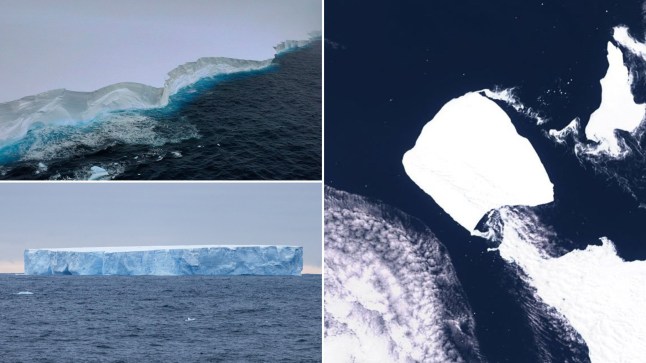
The world’s largest iceberg which is visible from space is heading on a collision course towards a remote British territory.
Dubbed A23a, the giant ice sheet first broke off from Antarctica in 1986 but was trapped by the seafloor, before it broke free in December last year.
Now, there are fears for wildlife in South Georgia, a British territory near South America.
Birds and seals previously died after icebergs ‘stopped them from feeding’, according to the BBC.
Captain Simon Wallace of the ship Pharos, based out of South Georgia, told BBC: ‘Icebergs are inherently dangerous. I would be extraordinarily happy if it just completely missed us.’
The sides of the giant iceberg measure more than 1,000 feet tall, and the ice sheet is the size of Cornwall.
A23a first began slowly moving south in 2020 but became trapped in what’s called a Taylor Column in the spring of 2024.
A Taylor Column is a phenomenon where rotating water above a seamount traps an object in its place.
If the iceberg changes course, once it reaches the Atlantic, A23a is expected to melt due to increased temperatures.
The South Atlantic Ocean, off the coast of South America, is usually around 5°C, which is considerably warmer than the Southern Ocean.
The ‘megaberg’ is being studied by researchers aboard the RRS David Attenborough, a 125-metre long research vessel built in 2024.
Laura Taylor, a biochemist aboard the ship which is currently off the coast of the Falkland Islands, said: ‘We know that these giant icebergs can provide nutrients to the waters they pass through, creating thriving ecosystems in otherwise less productive areas.
‘What we don’t know is what difference particular icebergs, their scale, and their origins can make to that process.
‘We took samples of ocean surface waters behind, immediately adjacent to, and ahead of the iceberg’s route.
‘They should help us determine what life could form around A23a and how it impacts carbon in the ocean and its balance with the atmosphere.’
Get in touch with our news team by emailing us at webnews@metro.co.uk.
For more stories like this, check our news page.
MORE: Driving licences are about to get their biggest change in years and will look very different
MORE: Top scientist gives his verdict on if aliens are real
MORE: Warning after stowaway snakes and tree-frogs hide in common potted plants









